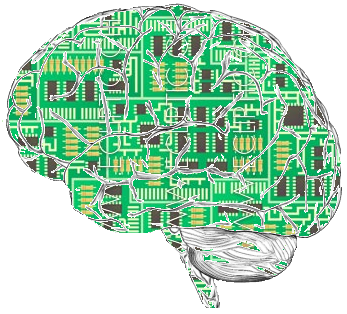Can our machines become self-motivated environmental learners?
The environmental movement has always been challenged by machines—the internal combustion engine, steam-powered turbines, production devices of every type and size—mechanisms consuming resources and generating waste during the long chain of events required to produce products (which often ended up themselves as waste). Old machines had rudimentary feedback systems like governors, gyroscopes, and other servomechanisms. These systems rarely provided any control of environmental parameters, but they did have an important characteristic: they operated independent of human operators—a precursor of things to come.
Over time, statistical and then numeric control systems let us achieve increasing control over machines, which often translated into environmental gains. We can thank software for significant improvements in the efficiency of hardware. Automobile emission control systems can co-optimize a wide range of operating parameters to allow our cars to keep rolling with fewer emissions. Similar optimization programs, often rule-based and predictive, were built into controls for steel furnaces, refrigerators, and heating and cooling systems, reducing energy requirements and environmental impacts.
But, the next generation of computers and control systems will learn without having to be explicitly programmed by humans and in response to new data—capabilities known broadly as machine learning. This learning ability will be increasingly integrated into everything around us through sensors and networks (including the so-called Internet of Things). There are now almost seven billion Internet-connected devices on the planet, and some predict that number reaching 20 billion by 2020.
 |
At this point, skeptics will note that we have been patiently waiting for the AI revolution for decades. Why is it likely to happen now? It is a combination of big data, fast processors, better algorithms, and cash (venture capital investments in AI were almost $2.8 billion in 2015 and expected to exceed $4 billion in 2016). We are also beginning to see some tantalizing examples such as the medical diagnostic capabilities of IBM’s “cognitive cloud” computer Watson, the new machine learning program from Google’s Magenta project, which wrote a 90-second piano melody, and Uber’s self-driving truck that recently delivered 50,000 cans of Budweiser beer on its first test drive in Colorado.While the environmental movement was using laws to bludgeon technical systems into their proper environmental place, machines were getting smarter and more connected. In fact, the more machines interact with each other and with us, the smarter they can become, an example of what psychologist and computer pioneer J.C.R. Licklider dubbed “man-computer symbiosis.” Fast forward to today, and you find firms like Google, Facebook, Microsoft, and Amazon redefining themselves as artificial intelligence (AI) companies.
Let’s imagine a future where our cities, transportation systems, utilities, and production chains become self-motivated learners. We have the opportunity to embed environmental learning into these systems: power grids self-optimize to reduce greenhouse gas emissions while managing loads, self-aware supply chains chose routing that optimizes delivery times while minimizing local ground-level ozone pollution, and your self-driving car learns about your environmental preferences and begins to chose the most energy and environmentally optimal paths to work (Honda has just developed a concept car, the NeuV, that senses the driver’s emotions and will develop emotions of its own).
But precisely because this learning is intrinsic and largely invisible, it might not happen. A first step would be to embed environmental considerations into the research and development efforts on machine learning—“algorithmic environmentalism” one might call it. Ethicists are already engaged with researchers developing self-driving cars to embed ethical considerations into collision-avoidance algorithms. Why not engage environmentalists? Once internalized in the machine learning system—through algorithms and associated data—rapid experimental cycles and hypothesis testing could accelerate and refine environmental performance strategies.
It would also help if the environmental movement initiated a dialogue on the opportunities and possible risks presented by learning systems and considered ways to capitalize on the AI revolution. Machine learning might be the ultimate example of so-called “private environmental governance,” where the learning and its outcomes become endogenous to the system rather than imposed from the outside through laws, regulations, and enforcement efforts. Machine learning systems, if properly implemented, could have significant advantages over slow-changing polices and slow-moving agencies in terms of speed, flexibility, and the environmental management of complex socio-technical systems that will shape our world and lives in the future.
The late Marc Weiser, who coined the term “ubiquitous computing” while at Xerox in the 1990s, once said that, “The most profound technologies are those that disappear. They weave themselves into the fabric of our lives until they are indistinguishable from it.” That is why environmentalists need to be part of the next machine age.
